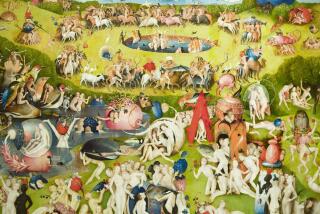Love, loss and taxidermy in Lydia Milletâs âMagnificenceâ
Lydia Milletâs âMagnificenceâ is a novel of ideas. I mean that as a high compliment, for the ideas Millet invokes are the only ones that matter: life, death, love, longing, extinction, the ongoing existential quandary of what we are doing here.
The final installment in the trilogy that began with 2008âs âHow the Dead Dreamâ and continued with last yearâs âGhost Lightsâ is an ambitious book, not so much for the sweep of its action, which is essentially domestic, but for its deep and nuanced investigation of inner life.
âIn an instant,â Millet writes, âthe whole of existence could go from familiar to alien; all it took was one event in your personal life. You might think you were only a mass of particles in the rest of everything, a mass exchanging itself, bit by bit, with other masses, but then you were blindsided and all you knew was the numbness of separation.â
An event like that is the precipitating event of âMagnificence,â the big bang from which the novel expands.
The book begins with a woman named Susan driving with her daughter, Casey, âdown La Cienega at rush hour,â heading for LAX to meet her husband, Hal. At the airport, Susan and Casey discover that Hal has been âkilled, killed with a knife in a mugging,â left for dead in the streets of a foreign city and returned home as air cargo, loaded in a coffin into the belly of a plane.
For Susan, the trauma is complicated, a mix of loss and guilt. Hal left for Central America not out of altruism or even a sense of adventure but because she drove him away with her infidelity.
âAs Hal lost his life she lost her own, as Hal was a murder victim she was an extension of him. That slut, that slut with the husband who got stabbed to death,â Millet writes. But almost immediately, she turns away from self-loathing and toward a kind of self-defense.
âIt made her feel better,â she continues, âto think selfishly. She should think steadily of herself, not of Hal.â
Millet takes a big risk, beginning âMagnificenceâ with what is arguably its most dramatic bit of action; we expect a novel to build to something like this. And yet, by playing against expectation, she allows us to read the book on its own terms.
If youâre familiar with âHow the Dead Dreamâ or âGhost Lights,â youâll recognize the characters here: Susanâs employer, T., was the protagonist of the first book, and Halâs search for him, after he disappeared in Central America, provides the spine of the second.
âMagnificence,â however, is about more than merely closing out the series. Rather, it has its own concerns, its own momentum, driven by an essential, and irresolvable, conundrum: What is the meaning of survival in a world where everything dies?
Visiting Hal at the funeral home, Susan imagines herself not in his position exactly but in the equivalent position she will one day inevitably occupy.
âShe would cease to be and join him,â she reflects. âJoin him in the sense of not joining him at all, in the sense of a parallel but utterly separate annihilation, join him in the sense of an eternal nonexistence that contained nothing.... You knew nothing of death and then you died.â
Is this the wrong place to say that Millet is very funny? Itâs a particular kind of humor, more Samuel Beckett than David Sedaris, but throughout the book, she makes us laugh at our absurdity, our futile attempts to stand up to the madness of a planet in which everything dies.
Halâs funeral is just the start of it; later, Susan inherits an estate in Pasadena, only to find taxidermic specimens in every room.
âShe pulled the curtains open as she passed them, turned on lights and moved past the staircase, into a living room with more animals still,â Millet writes. âHere there were cats. Cheetahs or leopards maybe, she didnât know the difference â not tigers, anyway. More than just heads, there were whole bodies posed leaping, posted stalking, streamlined with huge round eyes and furs that seems less their own than the coats of the rich.â
Were Millet out to score points â about the indulgences of the wealthy, about waste or the environment â such a moment might fall flat. Her purpose, though, is to see these creatures as a reflection of some desire, however misguided, to bring the dead to life.
That recalls âHow the Dead Dream,â where T. becomes obsessed with endangered species; two books later, living in a house full of stuffed and mounted creatures, Susan echoes some of these concerns. But, again working against expectation, she comes to see taxidermy as an art of preservation, a reflection of both biological imperative (our need to hunt, to kill) and the desire to step outside biology, to survive beyond ourselves.
Millet makes this tension explicit from the first pages of the novel, where Susan reflects on the differences between women and men.
âThe men were all insane,â she thinks, âbasically due to testosterone. You could see it in them, roiling under the surface.... The latent madness and retardation of men was compounded by the fact that most of them didnât get to kill their own prey anymore, stalk living things and slay them in a savage bloodletting.... The men, even when they didnât know it, were frustrated by this. They were unfit to live in civilized society.â
âMagnificenceâ has a lot to do with such an observation, especially its implications about civilization and savagery. Similar concerns infuse âHow the Dead Dreamâ and âGhost Lights,â but here Millet takes it further, asking us to rethink not just the answers but also the questions we ask.
Like T., sneaking into zoos in âHow the Dead Dream,â Susan finds in her menagerie of the dead a fleeting reassurance, a sense that the urge to kill, and the need to die, might leave something lasting â or, at least, human â in spite of itself.
By novelâs end, she has opened her house to a bevy of old women, their impending extinction an echo of the fate of the animals. âWe are the memories of others,â Susan thinks, âwe are the memory of ourselves.â
More to Read
Sign up for our Book Club newsletter
Get the latest news, events and more from the Los Angeles Times Book Club, and help us get L.A. reading and talking.
You may occasionally receive promotional content from the Los Angeles Times.









